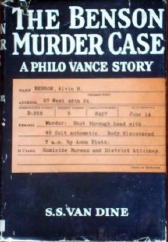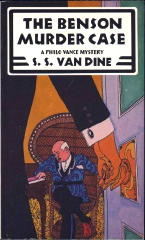Fri 11 Jul 2008
TMF Review by William R. Loeser – S. S. VAN DINE The Benson Murder Case.
Posted by Steve under Authors , ReviewsNo Comments
by William R. Loeser

…We are often reminded that it is not polite for critics to discuss who did it or how. I say that, if we are going to write criticism – which I define as discussion of strengths and failings of books and authors – of detective fiction, the who and how are exactly what we should be writing about. To the extent the means and/or the murderer is memorable, the book is memorable – as detective fiction …
In the interest of space and weight, I recently took along a paperback copy of S. S. Van Dine’s The Benson Murder Case (1926) to the laundromat rather than some hard cover book higher on my reading list. This is the public’s introduction to Vance, and Vance’s first exposure to detection which came to overshadow various connoisseurships and collecting interests among his hobbies.
In it he gives long disquisitions on the superiority of psychological to physical evidence, which, while boring, are at least better than the parade of esoteric trivia he later became infamous for. Vance does make a good and important psychological deduction in the early going; that the vain and lecherous Alvin Benson could have been murdered only by a male intimate because he wouldn’t have granted an interview to a woman or a mere acquaintance while not wearing his toupee and false teeth.

Having done so, Vance permits and occasionally abets his foil District Attorney Markham to harass the innocent suspects, who had conveniently grouped themselves in the neighborhood of Benson’s house on the fatal night like Christmas carolers, for the middle 3/4 of the book, merely remarking from time to time, “Markham, you’re going at it the wrong way.”
Markham endures this amateur criticism in silence with only one outburst in the middle of the book and list of suspects, inquiring as to what the right way might be. Vance replies to this effect, “You wouldn’t understand,” and the inquisition goes on until only one person remains uncleared (i.e. heretofore unsuspected).

Then, with the aid of a bit of illegal entry, Vance deftly breaks that gentleman’s alibi, forces his confession, and sits back to await the plaudits of the dumbfounded official investigators. Based on this book, Philo Vance doesn’t deserve “a kick in the pance,” just avoidance. (This is one author about whom Thomson’s opinion and mine are at great variance.)
Two minor points. One of the suspects, a supercilious fop almost in Vance’s class, is presented as a caricature to be ridiculed. Van Dine was sailing very close to the wind here. New York City buffs will be interested to learn that at the time of writing, Sutton Place/York Avenue was more prosaically known as Avenue A.
FOOTNOTE: H. Douglas Thomson, referred to at one point in this review, was the author of Masters of Mystery: A Study of the Detective Story (Dover, 1978; originally Collins, UK, 1931). E. F. Bleiler called it “the first English-language work devoted to serious criticism and history of the detective story.”
BIBLIOGRAPHIC DATA:
S. S. VAN DINE – The Benson Murder Case. Charles Scribner’s Sons, 1926. Hardcover reprints include: A. L. Burt, no date (shown); Gregg Press, 1980. Paperback reprints include: Pocket #333, 1945 (shown); Fawcett Gold Medal T2006, no date (ca.1968); Scribner’s, 1983 (shown).
[UPDATE] 07-18-08. I’ve just posted another review of The Benson Murder Case, this one by Mary Reed, not in reply, but written independently by her and sent to me late last year. (I’ve just pulled it out of my “to do” list, which as usual, I’m way behind on.)
— Steve